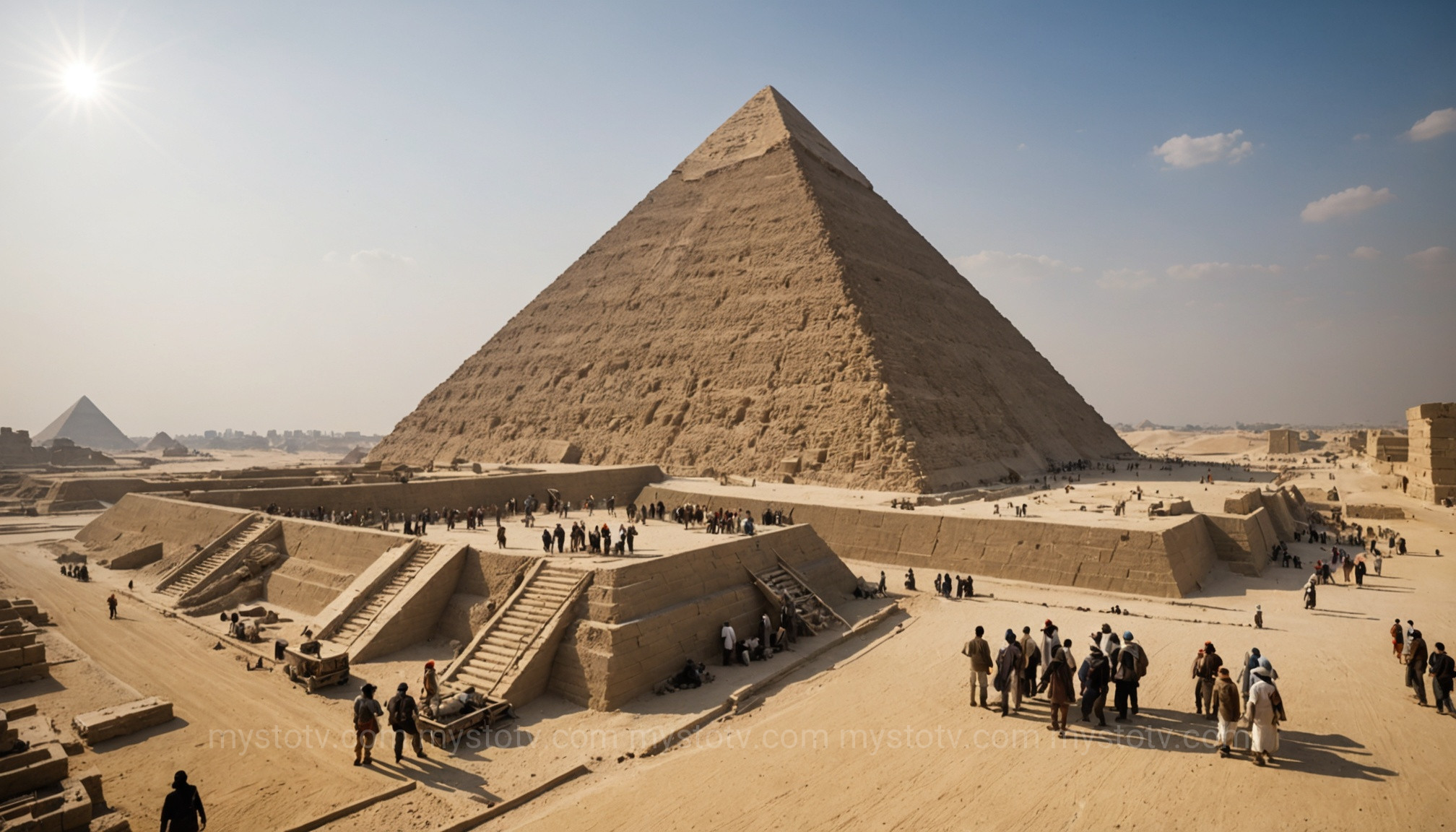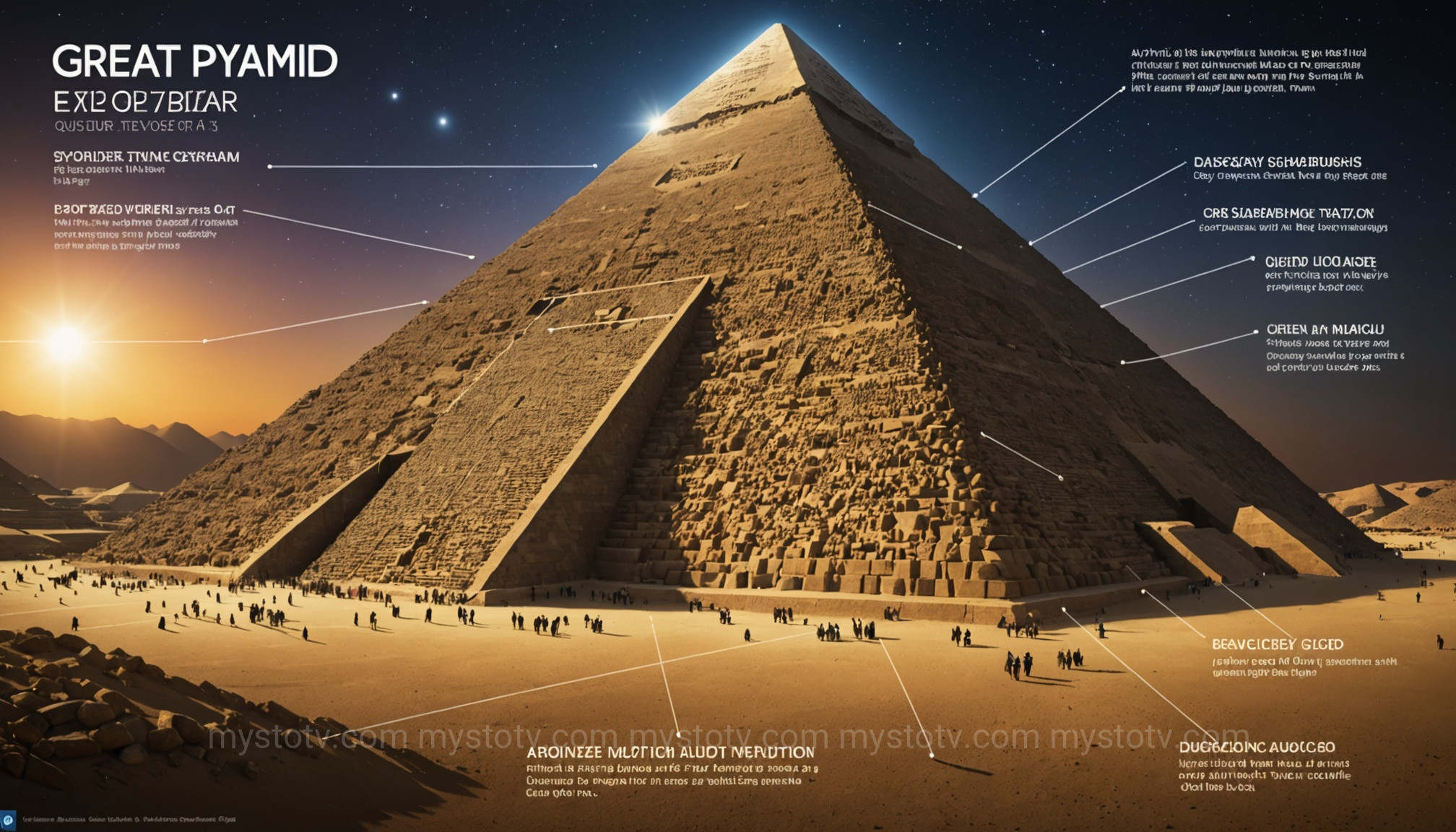Contents
- 1 The Construction Enigma: Unraveling the Great Pyramid Mysteries
- 2 Hidden Chambers and Passageways: Exploring Unseen Pyramid Mysteries
- 3 Astronomical Precision and Alignment: The Celestial Pyramid Mysteries
- 4 Unconventional Theories: Addressing Alternative Pyramid Mysteries
- 5 Conclusion: The Enduring Legacy of the Pyramid Mysteries
The Construction Enigma: Unraveling the Great Pyramid Mysteries

Perhaps the most fundamental of all the pyramid mysteries is how a Bronze Age civilization, without the aid of modern machinery, managed to quarry, transport, and assemble over 2.3 million stone blocks, some weighing up to 80 tons. The precision is staggering; the outer casing stones were so perfectly fitted that a razor blade cannot be inserted between them. This feat has given rise to numerous theories, ranging from the plausible to the extraordinary.
The Quarrying and Transport Conundrum
The majority of the blocks used were limestone, quarried locally on the Giza plateau. However, the more significant granite blocks used for the King's Chamber were sourced from Aswan, over 500 miles to the south. The prevailing theory, supported by archaeological finds like the Papyrus of Merer, suggests the Egyptians were masters of logistics. They likely used barges to float the massive stones down the Nile River during the annual flood season. Once on land, evidence suggests the blocks were hauled on large wooden sledges. A famous tomb painting depicts workers pouring water on the sand in front of a sledge, a technique experimentally verified to reduce friction by over 50%, making the task arduous but achievable for organized teams of laborers.
The Ramp Theories: Solving One of the Greatest Pyramid Mysteries
Lifting the blocks into place presents another layer of mystery. For decades, the dominant theory proposed a long, straight external ramp. However, calculations show such a ramp would have required more material than the pyramid itself and would have needed to be impossibly long to maintain a manageable gradient. This has led Egyptologists to consider more complex solutions. The most widely discussed modern theory, proposed by French architect Jean-Pierre Houdin, is that of an internal ramp. This theory posits that an external ramp was used for the lower third of the pyramid, after which construction moved to an internal, corkscrew-like ramp to raise the remaining blocks. This hypothesis elegantly explains the lack of evidence for a massive external ramp and is supported by microgravimetry surveys that have detected spiral-shaped anomalies within the pyramid's structure, hinting at one of the most compelling solutions to these construction-related pyramid mysteries.
The Workforce: Slaves or Skilled Artisans?
The popular Hollywood image of thousands of slaves being whipped into building the pyramids is a myth. Archaeological discoveries, including a dedicated workers' village and well-tended cemeteries near the pyramids, have completely reshaped our understanding. These findings indicate that the builders were skilled Egyptian laborers. They were well-fed, received medical care, and were buried with honor near the sacred structures they helped create. They likely worked in rotating shifts, possibly as a form of civil service or religious devotion to the pharaoh, who was considered a living god. This evidence transforms the narrative from one of oppression to one of a highly organized, motivated, and respected national project.
Hidden Chambers and Passageways: Exploring Unseen Pyramid Mysteries
While the known chambers—the King's, Queen's, and Subterranean Chambers—have been studied for centuries, the idea that the pyramid holds yet more secrets is a powerful driver of modern exploration. The use of non-invasive technology has opened a new chapter in the quest to solve these internal pyramid mysteries, revealing that the solid-looking monument may have more voids than previously imagined.
The ScanPyramids Project and the "Big Void"

In 2017, the international ScanPyramids project announced a groundbreaking discovery using cosmic-ray muon radiography, a technique that can detect density changes inside large stone structures. They found a massive, previously unknown cavity, dubbed the "Big Void" or ScanPyramids North Face Corridor. Located above the Grand Gallery, this void is estimated to be at least 100 feet long. Its purpose remains one of the most tantalizing pyramid mysteries. Is it a structural-stress-relieving chamber, an undiscovered corridor, or perhaps the location of Khufu's true, unplundered burial chamber? Without direct physical access, its function is purely speculative, but its existence proves that the Great Pyramid has not yet revealed all its secrets.
The Queen's Chamber Shafts: A Miniature Mystery
Extending from the north and south walls of the so-called Queen's Chamber are two narrow shafts, only about 8 inches wide. Unlike the shafts in the King's Chamber which lead to the pyramid's exterior, these terminate within the structure. Several robotic explorations have journeyed up these shafts, most famously revealing a series of limestone "doors" with elaborate copper handles. In 2011, the Djedi Project's robot drilled through the first door only to find a small, empty chamber and another, rougher stone blocking the path. The purpose of these shafts is intensely debated. Theories range from simple ventilation shafts (unlikely given they are sealed) to symbolic "star shafts" intended to guide the pharaoh's soul towards specific constellations like Orion and Ursa Major. These small passages represent a microcosm of the larger pyramid mysteries.
Astronomical Precision and Alignment: The Celestial Pyramid Mysteries
The Great Pyramid is not just a structural marvel; it is an astronomical one. Its alignment and proportions suggest its builders had a sophisticated understanding of mathematics and the cosmos, leading to some of the most profound pyramid mysteries of all. The structure serves as a massive, stone-built map of ancient Egyptian cosmology.
The Orion Correlation Theory
One of the most famous (and controversial) theories outside mainstream Egyptology is the Orion Correlation Theory, proposed by Robert Bauval. He argues that the layout of the three pyramids on the Giza plateau—Khufu, Khafre, and Menkaure—was deliberately designed to mirror the three stars of Orion's Belt. He suggests the "air shafts" in the King's Chamber also point directly to Orion (representing the god Osiris) and other significant stars. While many Egyptologists challenge this theory, citing inconsistencies and pointing to simpler terrestrial explanations for the pyramid's placement, it remains a powerful and popular idea that highlights our desire to connect these earthly monuments with the heavens. The potential for such a celestial blueprint is one of the most debated pyramid mysteries. This search for hidden designs relates to the ongoing search for other unseen pyramid mysteries.
Precise Cardinal Alignment
Beyond any specific star correlation, the pyramid's alignment to the cardinal points (North, South, East, West) is undeniably brilliant. The structure is oriented with an accuracy of within four arc-minutes, or one-fifteenth of a single degree. Achieving such precision without modern tools is a remarkable feat. The leading hypothesis is that the ancient Egyptians used a "solar gnomon" method, tracking the shadow of a vertical pole throughout a day to find a true east-west line, or the "circumpolar star" method, which involves tracking a single star's movement around the celestial pole. Either technique would have required meticulous observation and advanced knowledge of geometry.
Unconventional Theories: Addressing Alternative Pyramid Mysteries
No discussion of pyramid mysteries would be complete without addressing the more unconventional or "fringe" theories that have captured the public's imagination. These hypotheses often posit that the Great Pyramid was built with the help of extraterrestrial beings or by a lost, highly advanced human civilization like Atlantis, possessing technology far beyond our understanding of the ancient world.
The analysis of these theories reveals more about modern psychology than ancient history. They thrive by pointing to genuine gaps in our knowledge—the unsolved questions about construction and purpose—and filling them with spectacular, all-encompassing answers. Proponents argue that the scale, precision, and mathematical constants (like Pi and Phi) supposedly encoded in the pyramid's dimensions are proof of a higher intelligence. However, these theories consistently lack a critical component: verifiable physical evidence. While archaeology has unearthed the tools, settlements, and records of the Egyptian builders, there is a complete absence of any non-terrestrial artifacts or evidence of lost super-technology. Mainstream science suggests that the mathematical correlations are often the result of coincidence or can be explained by simpler construction and measurement techniques. The enduring appeal of these alternative pyramid mysteries stems from the sheer awe the structure inspires—it seems so perfect that it feels almost superhuman.
Conclusion: The Enduring Legacy of the Pyramid Mysteries
The Great Pyramid of Giza is the ultimate ancient enigma. It is a puzzle box built on a continental scale, and each answered question seems to unlock a room full of new ones. From the Herculean effort of its construction to the celestial precision of its design and the secrets potentially still sealed within its stone heart, the pyramid mysteries continue to challenge and inspire us. While science, through tools like muography and robotics, is slowly peeling back the layers of speculation, the monument's true power lies in its ability to stand at the intersection of history, science, and myth. The quest to solve the great pyramid mysteries is a journey into our own past and a reflection of our unending curiosity about the limits of human potential.